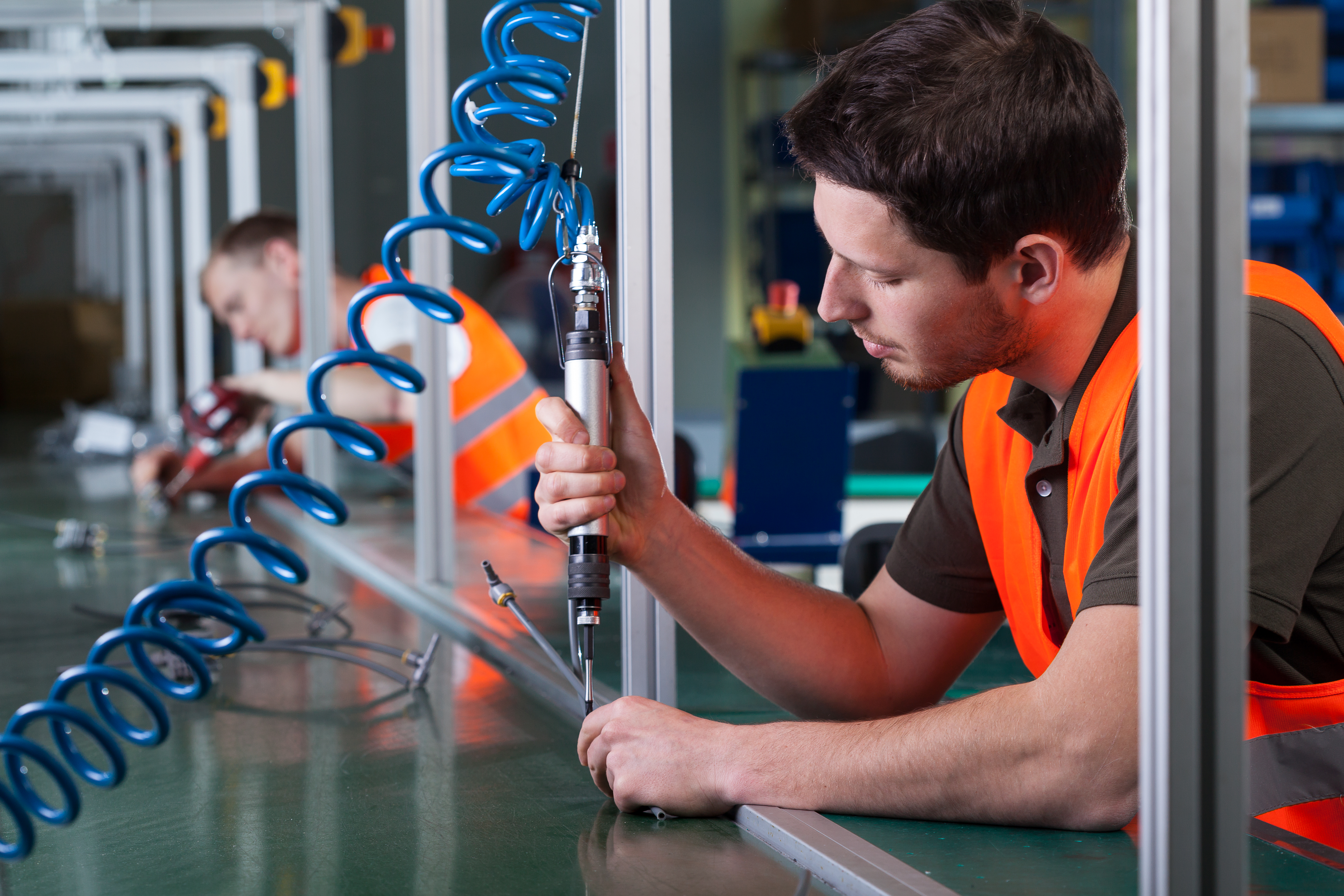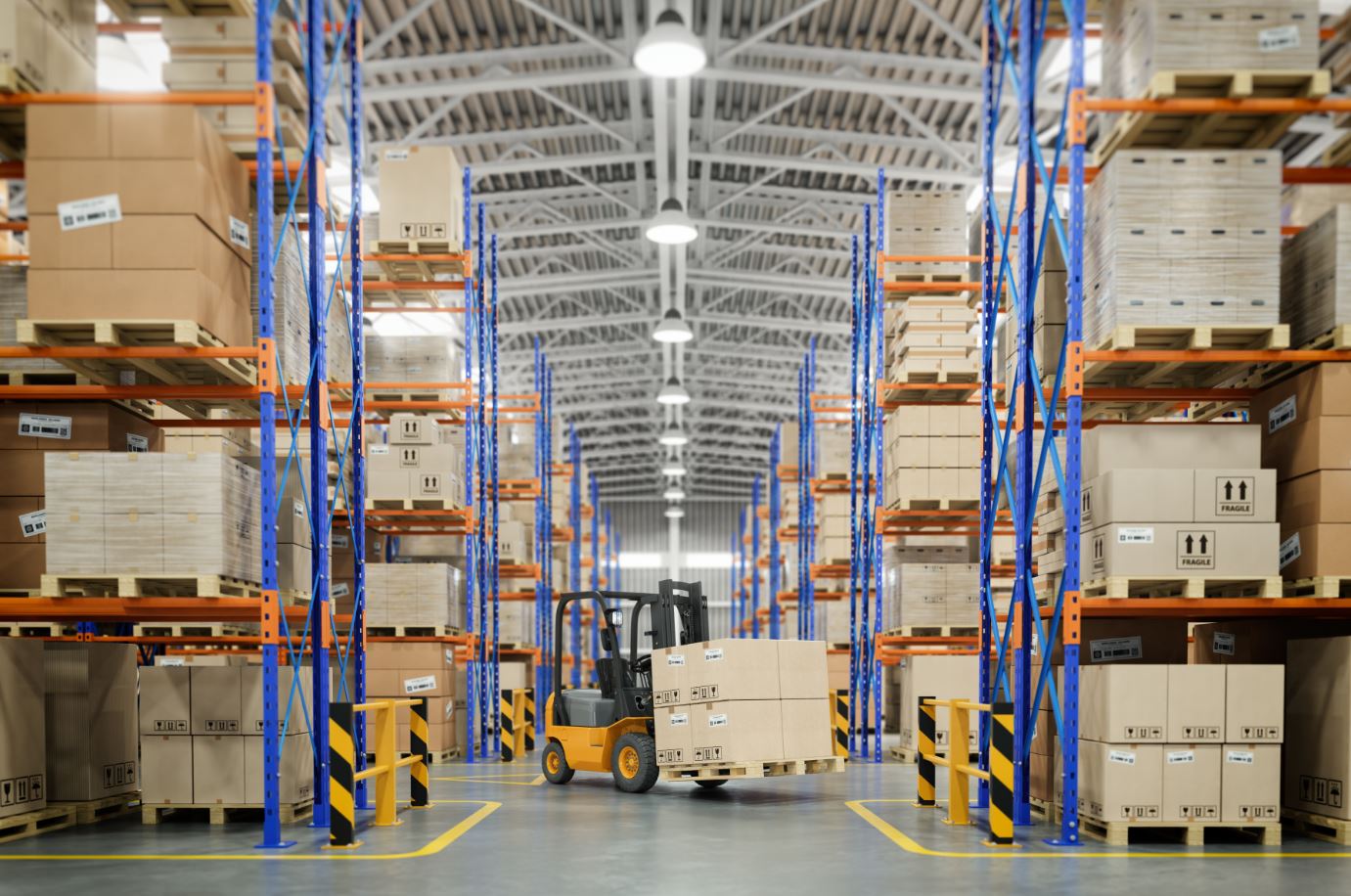
by Lean Material Handling | Apr 9, 2018 | Warehousing
Moving your inventory manually is tiresome and can take a lot of time. But with the use of forklifts, the job has been simplified. Warehouse management can, therefore, relocate their labor somewhere else or save a little money by cutting down on the labor force. However, forklifts, no matter how effective they are, they present some safety concerns that if not addressed can become a liability. Warehouses and any other businesses that use these machines should observe forklift safety. Proper use of the forklifts ensures employee safety as well as inventory safety.
While warehouses may have taken measures to ensure their employees are insured as well as the inventory, it is still logical to make the warehouse a safe environment for everyone. If employees feel safe, there is nothing preventing them from doing a perfect job therefore forklift safety and other measures acts as a good motivation. Also, safety should be emphasized as much as you underscore the need for speed in the warehouse operations. Below are five safety tips that should be observed;
Inspect the forklift
Firstly, you must make sure that the machine you are operating is up to standards. You do not want it breaking down in the middle of moving inventory. That could have ugly consequences to the driver and other workers around the warehouse. It could be carrying a heavy load when the break down occurs or even worse, it loses its brakes, and the operator has no control. So, check the forklift and do the necessary repairs. The shift supervisor should know of any problems and adhere to the safety rules. Also, the forklift should be fuelled and packed carefully when not in use. The inspection of the forklift should be a daily thing and never assume that its fine from yesterday routine check.
The operator must be qualified
Avoid putting your employees in danger by hiring qualified forklift operators. The operator must provide proof of certification and be assessed. The operator should wear the seat belt and the proper operating attire. After all, this is all part of training. A refresher course can be offered to ensure the qualification is completed to a certain standard. The training should be per the OSHA regulations which have been formulated to maximize safety in the workplace. Experience is a factor to consider since the operator knows how to conduct themselves.
Pay attention during operation
There is a lot of traffic in the warehouse. The pedestrians can be harmed if they bump into the forklifts. Another source of danger is loads falling off the fork. Paying attention is hence an critical forklift safety tip. It ensures you do not run into other forklifts and employees. If the load obstructs your path, have some help finding your way or drive in reverse.
Be considerate to others
Forklift safety dictates you put others in mind. That means no fast moves, sudden turns and always alert people you are around. Educating other employees is also another way to prevent accidents. That is, asking them to stand or walk at a safe distance from the forks.
Watch the load
Avoid carrying more than the forklift can handle. Do not exceed the limit all in the name of efficiency and completing the job fast. Also, ensure the load is stable to prevent it from falling off affecting the forklift’s balance and increasing the risk of an accident. When putting it on the shelves, be careful.
Forklift safety allows smooth operations. Watching out for your employees is your number one priority, and these forklift safety tips will come in handy.

by Lean Material Handling | Apr 9, 2018 | Warehousing
A lot of work goes into managing a warehouse. From the time a product is produced to the moment, it reaches the customer, there are many processes involved, and these processes are the core of the warehouse organization. Warehouse processes are not immune to waste. The waste is usually the source of many warehouses failing to meet their goals. Therefore the reasonable thing to do is to try and eliminate waste.
The term used is lean manufacturing. It deals with handling waste from all corners of the warehouse. Be it on labor or inventory, lean manufacturing aids to enhance warehouse performance. To start with, why don’t you try eliminating waste by;
Checking your inventory
The supply chain depends on warehouse inventory to maintain the flow.
For this reason, warehouses will produce and stock more inventory to ensure that there are no shortages. It’s hard to believe that the inventory can be a source of waste. How this occurs is when there is overhead inventory.
The sales should determine the inventory. The production process, therefore, requires you utilize the sales data to minimize inventory overhead. Work to fulfill the short-term sales as you control the inventory.
Avoiding overproduction
Following inventory overhead, the next area to eliminate waste in the production process. Overproducing has its extra expenses. The labor required may need to double to meet the deadline. In doing so, you will be forced to budget for the additional employees. Overproduction also causes storage troubles. You will have to find extra space for the inventory which is difficult especially if it is slow moving.
The way to go about reducing overproduction is to cut the working hours accordingly and embrace lean batching. Also, do not overproduce so that you keep people working. If the demand doesn’t require an overproduction, do not do it otherwise you will have to face all the problems that come with this action.
Avoiding downtime
Time is a precious resource in warehouse management and other businesses. Halting a process for whatever reason, be it for additional inspection or waiting for parts, is another warehouse waste. This is what is referred to as the downtime. The downtime is eventually reflected in the overall quality of the product. You may miss a production step when trying to recover the time lost thereby compromising on quality. Also, the warehouse may need to spend a little more to reach the target on time.
Since customers are the ones who will suffer the consequences of downtime, it is essential to ensure that if it is unavoidable, it doesn’t affect the quality of products. Thus, eliminating downtime is the right thing to do and making early preparations assists warehouses to cut this time as they plan to ensure the warehouse processes are not affected by any inconveniences.
Taking into account these three wastes, the next thing to do is to use other methods of waste elimination to evaluate your warehouse operations. The evaluation, guided by lean manufacturing and six sigma methods of waste elimination, exposes the areas undermining smooth warehouse operations and those that need improving to achieve efficiency at low cost. Warehouse waste delays the processes affects the quality and the storage of the inventory.
If you want to improve quality, eliminate waste, reduce cost and reduce the lead times, this is how. Avoid downtimes, overproduction, and inventory overhead. In addition to these three ways, it is essential to use the lean manufacturing process to eliminate other kinds of waste in the overall warehouse operations.

by Lean Material Handling | Apr 9, 2018 | Lean Production
In business, sustainability matters just like profitability. The two go together since if a process profits the company and is sustainable, no one can do away with it. One way of achieving these two factors is through managing waste. Through the lean manufacturing methods of eliminating waste, a business can reach its goals without having to endure high cost finally. This agenda shouldn’t be a one-time deal. As a business, you need to continually evaluate your processes for waste and rid off it and improve areas that need improvement. Continual evaluation of your business and the waste in your process is what lean process improvement is.
The process is directed at continually improving the business processes and can be adopted in any industry. Now, lean process improvement is guided by the 5S methodology which stands for;
Sort- seiri
By sorting things in order of their use helps reduce time wasted and take care of distractions in business processes. Any items that are least used should be relocated somewhere else to save on space and any unnecessary items or operations eliminated. Through sorting, you will reduce the clutter that may be undermining your processes.
Set in order- seiton
After sorting, the next step in lean process improvement is optimally organizing the items. Those that are used more often needs to be within reach for a smooth workflow. Keeping commonly used tools nearby, and in fixed locations will be a significant time saver.
Shine – seiso
The third-S is more of maintenance. You know very well that proper support helps avoid repair costs and improve the quality of a process. In line with that, regular inspections, regular software updates, and always keeping the workplace clean not only ensure safety but also makes it easy to pinpoint problems before they escalate.
Standardize – seiketsu
Using the first three steps, certain things will change for the sake of lean process improvement. These changes need to be permanent and therefore standardizing processes makes it difficult to fall back contributing to growth. Whatever procedures you put in place and the schedules to be followed, they should be aimed at continuous improvement.
Sustain – shitsuke
Lean process improvement demands constant growth. Sustaining the adopted processes during the 5s methodology creates room for accountability. Training sessions, regular audits, implementing enhancements when necessary and other performance evaluation processes help promote sustainability.
Furthermore, lean process improvement shouldn’t be treated as an event. Instead, it is a mindset that organizations should use to solve systematic gaps in their processes. By viewing it as a mindset, delivering services to customers becomes easy as 123, and they do not struggle to maintain growth and improvement.
Lean process improvement, therefore, maximizes value and provides room for fast delivery. Through a scientific approach, businesses can identify opportunities, plan the processes that will achieve growth, execute implementation changes and finally review how well the changes are doing in the overall business process.
So you see, lean process improvement is essential in organizations for growth. However, if you want it to be effective, it has to be applied in all departments. Optimizing one sector of your business will mean that another will try to keep up or will be inconsistent with the new improved business structure, therefore, hurting the company. Thus, optimize all areas of your business using the 5s methodology.
Additionally, some tools have been developed to help organizations and businesses improve their processes. One of them is Nintex Promapp that manages the business process through lean tagging and tracking waste and cost.
Lean process improvement is that simple. Just follow the 5S methodology and watch your business processes improve and you will be able to keep eliminating waste.

by Lean Material Handling | Apr 9, 2018 | Material Handling, Warehousing
Pallets today are becoming an integral part of the modern warehouse and manufacturing logistics. They are not only being used for assembling, handling, storing and product transportation but also for sustainability. Sustainability is becoming more difficult to achieve with all the changes that are defining the manufacturing world with each passing day.
With that brief introduction, companies want to know which pallet designs will save them transportation and operational cost while helping them achieve sustainability. This has brought about the pallet pooling system which by the way, has received mixed reactions.
Pallet pooling is a useful trend that assures companies reduced costs, and they do not have to spend on their fleet continuously. That means they can redirect the money that would have otherwise been used for new pallets to other supply chain operations. However, not all will feel comfortable using the system. Mainly it’s due to their customized needs which is why some companies might prefer having their pallets.
They have to align with the companies systems. For instance, if they are using automation, they have to provide a viable solution. Consequently, you have to consider three things;
- Pallet strength – If they keep breaking down causing downtimes, then they are contributing to waste production decreasing the efficiency of the process.
- Pallet durability – Expenditures from having to buy pallets after a short while are a significant threat to companies stability and sustainability.
- Pallet reusability- Campaigns for a greener earth have worked marvelously as companies are looking for reusable pallets that will save fuel energy.
With these three factors, it is easy to find the best pallets. And wood pallets fit this description. They have existed longer than any other types. But given the changing circumstances, plastic and composite pallets are being used today as an alternative to wood. This trend has come to be because wood pallets have some flaws.
Taking the case of automated processes, plastic pallets are more preferred. Reason being they are uniform and identical, and therefore sensors can read data easily. Unlike wood pallets, which may vary slightly in size cause a lot of trouble in automated processes. The sensors have a hard time detecting edges. Also, wood may chip off jamming automation equipment. The consequences of using wood are that the system stops and you know how this affects the process. It will increase the downtime and the cost.
The only remedy to wood pallet inconveniences would be to use the plastic pallet designs once you automate your production processes. It saves time and future costs hence the best solution.
Additionally, plastic pallet designs are being re-engineered to increase their strength-to-weight ratios which reduce the breakdown risks, and since they are lighter yet strong, there is reduced fatigue. The injury risk for the workers are reduced as well.
Another pallet design that is in use is the customization of wood pallets to boost their strength and stiffness. Not all pallets support the different storage equipment. A three-stringer floor wood pallet has high chances of breaking when used for drive-in rack since it is weak and doesn’t help the design. The easy way out here is the collaboration between racking and pallet suppliers to ensure that the models work before their installation.
Lastly, manufacturers are coming up with sustainable, biodegradable and recyclable pallets that are geared toward reducing the companies’ environmental impact.
These trends are bound to take root firmly, and with the technological advancements and lean manufacturing methods being adopted, more pallet designs will emerge with the aim of improving sustainability.

by Lean Material Handling | Apr 9, 2018 | Lean Manufacturing, Warehousing
In line with the ultimate goal of Lean manufacturing, which is enhancing work environments to reduce waste and uphold production, various equipment is incorporated into the movement of paraphernalia around the factory. The most notable are forklifts and pallet carts. The former is slowly getting removed from factory floors due to the efficiency of pallet carts. The use of pallet carts has been observed to bring the following benefits:
Decongesting the Floors With Pallet Carts & Tugger Trains
Pallet carts can be automated to specific routes. Their movement can be configured in such a way that they take up minimum space, and deliver necessities from one point to another.
Loading containers on forklifts are albeit more complicated because they require more space to maneuver. One or more carts can easily be removed, allowing for the rest to move along to other destinations.

How to Increase Delivery Capacity
Operators of forklifts have to transfer weighty load in a limited number of containers and still have to travel back and forth before delivery is complete.
Pallet carts have revolutionized this field by introducing the ability to link multiple carts then deliver them in one journey. The number of carts is practically limited to the power output of the tugger in the series.
Forklifts may still need to be used in some factories, but are restricted to receiving and shipping.
Reducing Energy Consumption
Less energy is consumed when the number of tugger trips is reduced. If more materials are able to reach their destination in two trips instead of four, less waste is emitted. This runs well with the objective of lean manufacturing.
Another thing that is improved is required manpower. More people are needed to operate the traditional way of moving materials. A normal system will have to work with three people, whereas one controls the movement of the car, someone else loads new cargo, while still another unloads the cargo.
Help Reduce Wait Times
Production times can be cut by half with the use of pallet carts. In a study to compare the delivery speeds of forklifts and pallet carts, both were observed as they got loaded, traveled and unloaded packages of equal weight from point A to point B.
The findings from this study were rather pleasant to the researchers as it was discovered that pallet carts took 50% of the time required by forklifts to complete a designated job. The reasons behind such a huge difference were the perfect design of routes and detachability of the pallet carts.
Detaching and reattaching carts takes less than a minute, and eradicates production wait times.
The good thing with pallet carts is that they only need basic driving skills from operators. Those operated by hand have a notable abridged control panel which machinists use to guide the vehicle around with.
The operators need just a bit of training to enable them to run the machine efficiently.









